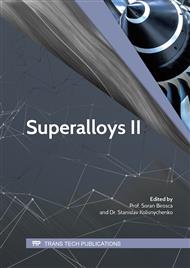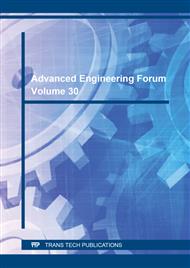[1]
Akıncıoğlu, S, Gökkaya, H and Uygur, İ., The effects of cryogenic-treated carbide tools on tool wear and surface roughness of turning of Hastelloy C22 based on Taguchi method,, Int. J. Adv. Manuf. Technol., vol. 82, no. 1–4, p.303–314, (2016).
DOI: 10.1007/s00170-015-7356-z
Google Scholar
[2]
Ulutan, D. and Ozel, T., Machining induced surface integrity in titanium and nickel alloys: A review,, Int. J. Mach. Tools Manuf., vol. 51, no 3, p.250–280, (2011).
DOI: 10.1016/j.ijmachtools.2010.11.003
Google Scholar
[3]
Choudhury, I., and El-Baradie, M., Machinability of nickel-base super alloys: a general review,, J. Mater. Process. Technol., vol. 77, no 1–3, p.278–284, (1998).
DOI: 10.1016/s0924-0136(97)00429-9
Google Scholar
[4]
Altin, A.,Optimization of the turning parameters for the cutting forces in the Hastelloy X superalloy based on the Taguchi method,, Mater. Tehnol., vol. 48, no 2, p.249–254, (2014).
Google Scholar
[5]
Kadirgama, K., Abou-El-Hossein, K.A., Noor M.M., Sharma, K.V., and Mohammad, B., Tool life and wear mechanism when machining Hastelloy C-22HS,, Wear, vol. 270, no 3–4, p.258–268, (2011).
DOI: 10.1016/j.wear.2010.10.067
Google Scholar
[6]
Kadirgama, K., Noor, M.M., Abou-El-Hossein, K.A., Mohammad, B., and Habeeb, H.H., Aspects of Wear Mechanisms of Carbide Tools when Machine Hastelloy C-22HS,, Adv. Mater. Res., vol. 83–86, p.295–302, (2009).
DOI: 10.4028/www.scientific.net/amr.83-86.295
Google Scholar
[7]
Kadirgama, K., Rahman, M., Mohamed, B., Bakar, R.and Ismail, A., Development of temperature statistical model when machining of aerospace alloy materials,, Therm. Sci.,vol. 18, p.269–282, (2014).
DOI: 10.2298/tsci120203112k
Google Scholar
[8]
Kadirgama, K., Abou-El-Hossein, K. A., Mohammad, B. and Habeeb, H., Statistical model to determine surface roughness when milling hastelloy C-22HS,, J. Mech. Sci. Technol., vol. 21, no 10, p.1651–1655, (2007).
DOI: 10.1007/bf03177389
Google Scholar
[9]
Khidhir, B. A., and Mohamed, B., Study of cutting speed on surface roughness and chip formation when machining nickel-based alloy,, J. Mech. Sci. Technol., vol. 24, no 5, p.1053–1059, (2010).
DOI: 10.1007/s12206-010-0319-2
Google Scholar
[10]
Khidhir, B.A. and Mohamed, B., Analyzing the effect of cutting parameters on surface roughness and tool wear when machining nickel based hastelloy – 276,, IOP Conf. Ser. Mater. Sci. Eng., vol. 17, no. 12043, pp.1-10, (2011).
DOI: 10.1088/1757-899x/17/1/012043
Google Scholar
[11]
Razak, N. H., Rahman, M. M. and Kadirgama, K., Response Surface Design Model to Predict Surface Roughness when Machining Hastelloy C-2000 using Uncoated Carbide Insert,, IOP Conf. Ser. Mater. Sci. Eng., vol. 36, no 12022, pp.1-9, (2012).
DOI: 10.1088/1757-899x/36/1/012022
Google Scholar
[12]
Chennamsetty, A.R.K., LeBlanc, J., Abotula, S., Parrikar, P. N., and Shukla, A., Dynamic response of Hastelloy® X plates under oblique shocks: Experimental and numerical studies,, Int. J. Impact Eng., vol. 92, p.75–88, (2016).
DOI: 10.1016/j.ijimpeng.2016.03.006
Google Scholar
[13]
Swaminathan, B.,Abuzaid, W., Sehitoglu, H., and Lambros, J., Investigation using digital image correlation of Portevin-Le Chatelier Effect in Hastelloy X under thermo-mechanical loading,, Int. J. Plast., vol. 64, p.177–192,(2015).
DOI: 10.1016/j.ijplas.2014.09.001
Google Scholar
[14]
Aghaie-Khafri, M., and Golarzi, N., Forming behavior and workability of Hastelloy X superalloy during hot deformation,, Mater. Sci. Eng. A, vol. 486, no 1–2, p.641–647, (2008).
DOI: 10.1016/j.msea.2007.11.059
Google Scholar
[15]
Abotula, S., Heeder, N., Chona, R., and Shukla, A., Dynamic Thermo-mechanical Response of Hastelloy X to Shock Wave Loading,, Exp. Mech., vol. 54, no 2, p.279–291, (2014).
DOI: 10.1007/s11340-013-9796-4
Google Scholar
[16]
Abotula, S., Shukla, A., and Chona, R., Dynamic constitutive behavior of Hastelloy X under thermo-mechanical loads,, J. Mater. Sci., vol. 46, no 14, p.4971–4979, (2011).
DOI: 10.1007/s10853-011-5414-y
Google Scholar
[17]
Li, R., Shih, A.J., Finite element modeling of 3D turning of titanium,, International Journal of Advanced Manufacturing Technology, p.2511–2516, (2005).
Google Scholar



